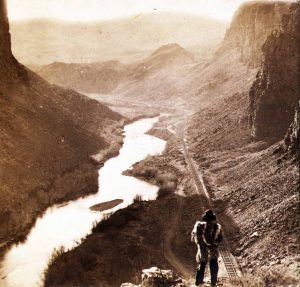Lee Maracle writes:
In order for criticism to arise naturally from within our culture, discourse must serve the same function it has always served. In Euro-society, literary criticism heightens the competition between writers and limits entry of new writers to preserve the original canon. What will its function be in our societies? (88)
In the following paragraphs in her essay, Maracle answers her question describing what she sees to be the function of literary criticism in Salish society. Summarize her answer and then make some comparisons between Maracle and Frye’s analysis of the role of myth in nation building.
In her essay “Toward National Literature – a National Treasure”, Maracle illustrates her frustration and concerns on the fragility that Salish culture has become due to the dismantling of its people during the colonial period. While Salish land was being fought over and colonized by foreigners, their children – carriers of Salish stories, culture, and tradition, “subjects of transmission” (79 Maracle) – were also being removed from their home. “We have been deliberately disconnected from our bodies of knowledge” (79 Maracle). Disconnection of people also meant disconnection of knowledge, where the previous generation and its stories were not being passed down, while subsequent generations had little resources to learn their culture, and a lack of a real place to create discourse with one another, thus creating new stories. “Since there is no location, institution, systemic, for the ordered aggregation, synthesis and transmission of First Nation knowledge…” (80 Lee), the new canon of storytelling was naturally overpowered by its European colonizers; completely changing the standards of how stories are critiqued and evaluated.
With that bit of Salish history established, Maracle discloses that the only ones that are qualified to make criticism “can only be done by those who live in the culture and study the base…” (84 Maracle). Which eliminates any foreign party that isn’t truly immersed in Salish culture, but also ones that have not academically studied historical Salish text, roots and culture.
On a mythical sense, Salish stories were a way to learn and establish an entire community’s way of life, and also to reflect on it through discourse, mainly in a live environment. First is to “understand”, second to “see oneself in the story”, and lastly to see it’s community through the story. Subsequent Salish stories strive to transform and improve on the way of living through such methodology. Unlike European way of discourse, It’s not so much about penmanship and demonstration of literature mastery among other writers. Salish stories directly reflected their morals, principals and most of all mythology, and they were continually created orally to match its contemporary generation. The quote following illustrates that in this point, Northrup and Maracle’s thinking aligned, “literature is conscious mythology: as society develops , it’s mythical stories become structural principals of storytelling”. (234 Frye)
Frye’s approach to criticism drew similarities to what Maracle speaks of, he did not feel like it was the writer’s job to make “value judgement”, especially as a “starting point of criticism” (6 Hutcheon).Frye’s approach to evaluating literature was very much based on writer’s intentions in regards to their piece of literature and not what he thought it should be. This to me, was a pretty refreshing take in criticizing, evaluating and reading stories. Throughout my personal academic journey, especially since university, I’ve been taught repeatedly to approach stories without the author in the picture, and let the writing itself speak for itself. Anything taught about the author was discussed as back-stock knowledge, not so much essential artifacts of understanding the story itself. I understand the idea behind this as to respect an artists work as an isolated entity. But, I’ve also always felt that it runs the risk of losing layers of depth to a story without connection to the creator and their perspectives and intentions.
Comparing the answers of both Maracle and Frye, I find are not conflicting, rather a good compliment to one another. Both writers stress on the importance of understanding deeply of the story’s roots, rather than the stories itself. And its between that space of object of the story and subject where myth is created. Mythology overtime becomes foundations of storytelling. Stories closely imitate the principals and morals of current society, and society in return mimick the stories that are being told, and its my understanding that in that process of back-and-forth rallying is where myth lies.
Both Maracle and Fry’s brought me back to a Greek Mythology class I took a few years back and the ancient Greek culture truly epitomized the idea of oral mythological story-telling. With the lack of science, technology or empirical data during its time, all things – tangible or ideological – were explained through Greek Gods and their stories of how and why things came to be. Obviously I can’t list all of its stories here, but, here is link that gives some of the best stories in Greek mythology. Here is also a documentary I’ve watched while I was taking the class for anyone that’s interested. It can be a little bit dry at times, but the commentary by its historians and mythologists were insightful in helping us understand its politics, culture and thought process during that time.
Works Cited
Maracle, Lee. “Toward a National Literature – “A Body of Writing”” Across Culture/Across Borders – Canadian Aboriginal and Native American Literatures(2010): 77-97. Print.
Hutcheon, Linda. The Bush Garden – Essays of the Canadian Imagination – Northrop Frye. Concord: House of Anansi, 1955. Print.
“Top 10 Greek Mythology Stories.” Owlcation. N.p., 15 Sept. 2016. Web. 8 Nov. 2016.
Greek Mythology God and Goddesses Documentary. 2013. Youtube. Web. 8 Nov. 2016.

